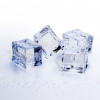The Chemistry of Coppers
Ingredients
- At least five copper coins with about the same amount of tarnish
- Three or four household liquids - such as vinegar, coke, apple juice, water
- A glass for each liquid
- A few pieces of kitchen towel
Instructions
 Put a couple of centimetres of each liquid into a separate glass.
Put a couple of centimetres of each liquid into a separate glass.- Put a copper coin into each glass. If you can balance them half in the liquid and half out that will make any changes really easy to see.
- After a couple of minutes, take the coins out and dry them on the kitchen towel. Don't forget which coin went in which liquid!
- Compare the coins. Which liquid made the colour of the coins change the most?
Result
Some liquids such as vinegar, lemon juice, orange juice Cola etc. all cause the coins to become cleaner, if you leave the coins half in the liquid they will become stripey. The half in the liquid will be clean and a pink colour, but the half that was out of the liquid will have stayed the same.

Explanation
 |
| Copper with an oxide layer on the right. |
All the liquids which had an effect on the coins are what's called acids. Acids tend to be very sour tasting things. When coins are left in your pocket for a long time, the copper in them reacts with the oxygen in the air and turns into copper oxide. That's the black gunky stuff on the outside of the coin. When you put that in an acid it will dissolve the copper oxide leaving behind just the shiny metal coin. Basically, if you ever want to clean any metals, acid is a good thing to do it with!
The acid has some hydrogen in it which will react with the oxygen in the oxide and turn into water. The more hydrogen atoms in the acid, the stronger the acid, the lower its pH, and the more shiny the coins will appear after being soaked. Vinegar is the strongest acid in our sample.

Once some of the hydrogens have dissolved the oxide and turned into water, this leaves the other half of the acid, which in vinegar is called the acetic group. So some of the copper is dissolved in that and sits around in solution. If you take lots and lots of coins and leave them in very strong vinegar for about an hour and you can see a slight green tinge. That's the copper in the copper acetate which looks slightly green. You definitely don't want to drink that!
This does also mean that cola drinks are corrosive and can dissolve your teeth in just the same way it dissolves the copper oxide. Cola drinks contain vast quantities of phosphoric acid. In fact, a certain global cola company is one of the world's largest consumers of phosphoric acid. It means that cola has a pH of about 3 or 3.5, just slightly different from dilute hydrochloric acid that you may use in labs at school.
Why do the coins go pink?
The coins go pink which is actually the colour of clean copper, what we call 'copper coloured' is the pink copper covered with a thin layer of black copper oxide.
- Previous The Science of Energy in the Gym
- Next Lifting Ice Cubes










Comments
Thanks for your help!
Thanks for your help!
is it better to put the coins
is it better to put the coins in the sun or fridge or at room temperature while conducting this experiment
Do the experiment and please
Do the experiment and please tell us!
It's no wonder that every
It's no wonder that every article about "cleaning hacks" out there says "just clean everything with vinegar and baking soda". I do consider it really effective, yes, but when it comes to a real cleaning session (I do it professionally anyway) you can't just pour vinegar on everything and expect it to be clean after. Here's some food for thought - if you accidentally sprinkle vinegar on your white wall, do you remove it with vinegar? :P
Sorry for the rant, this experiment is still fun to try at home!
Keep the entertaining articles up!
Best, Conor Craig, cleaning expert
How many time I will have to
How many time I will have to wait till the coins becomes pink.
As it says in the
As it says in the instructions above "After a couple of minutes"
Add a comment